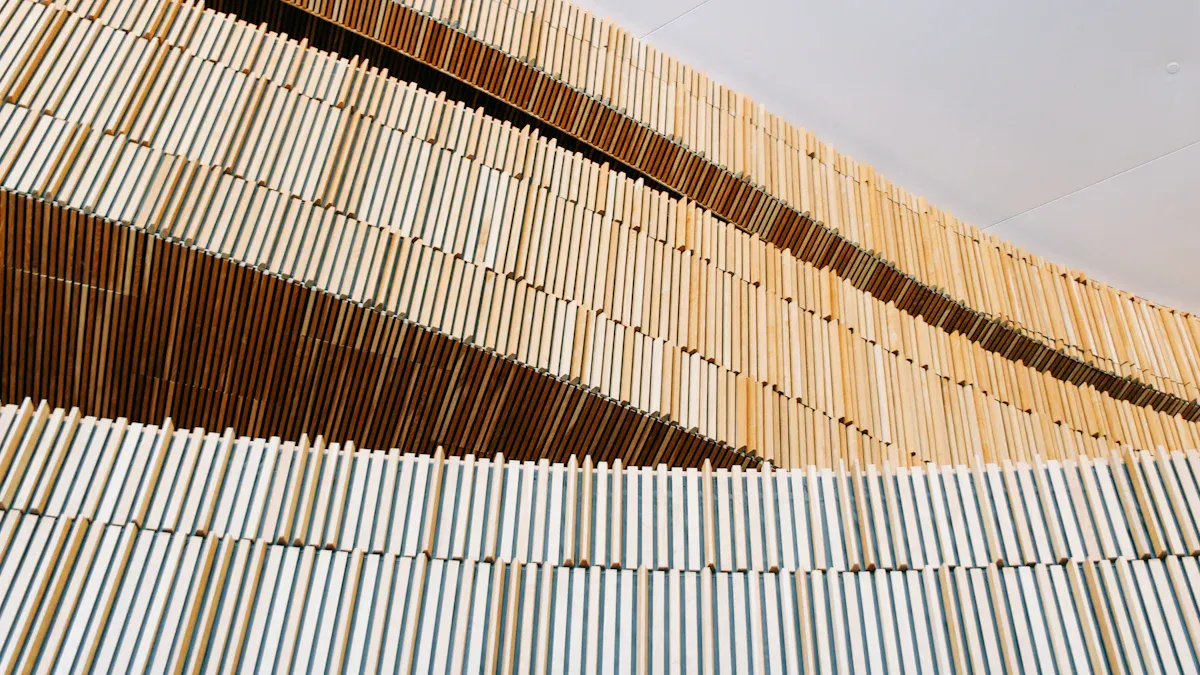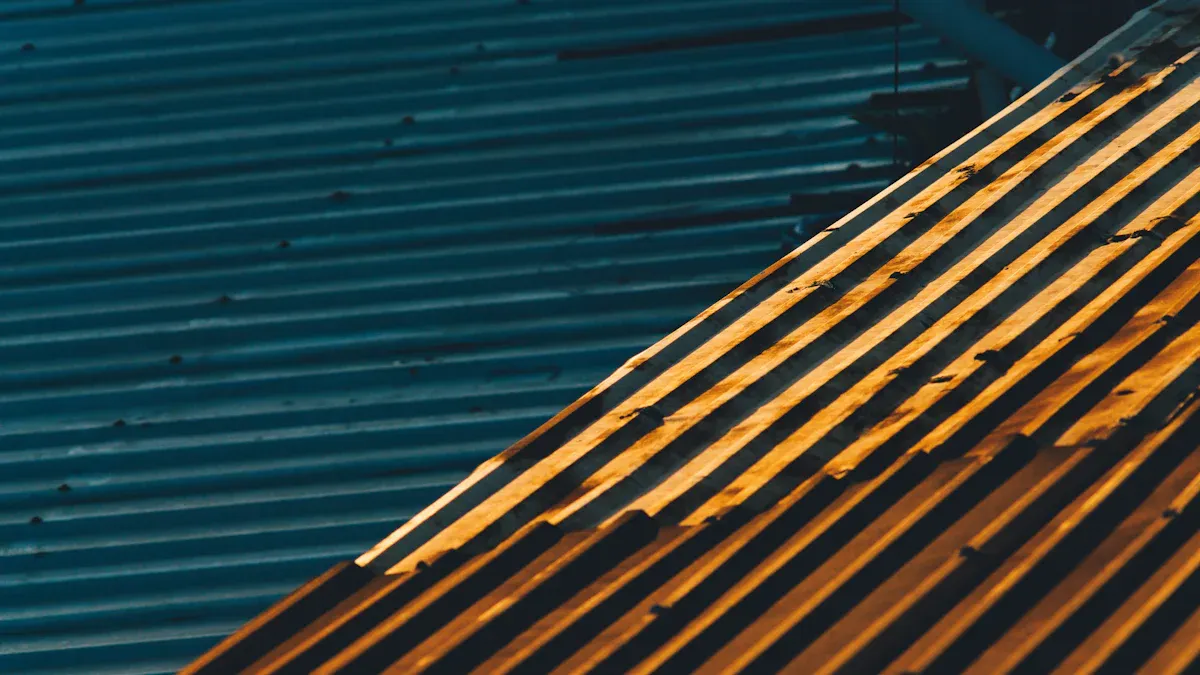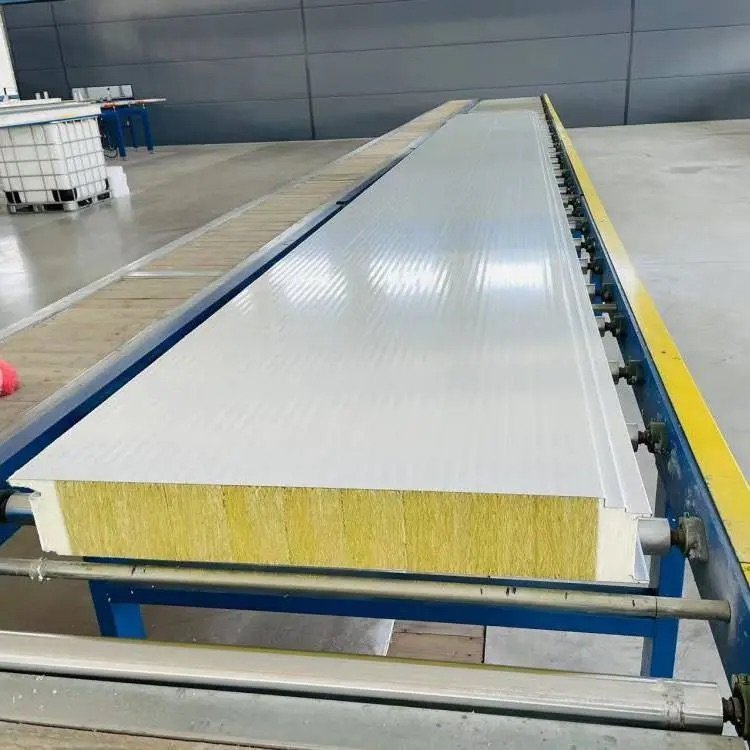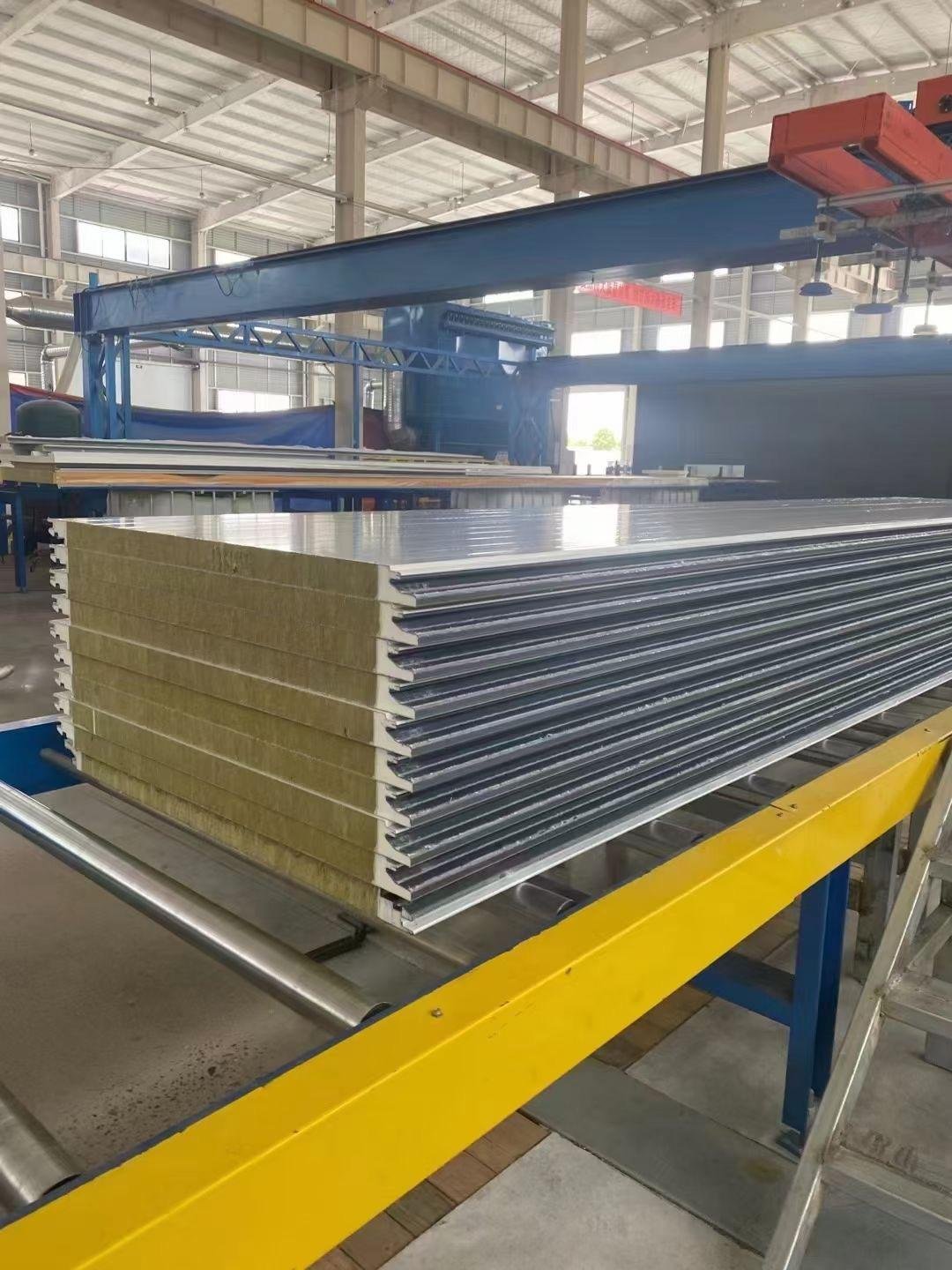
Sandwich panels are modern building materials made for strength and insulation. They are also lightweight and easy to use. These panels have three main parts: outer layers, a core, and glue. The outer layers are often made of Fiberglass Reinforced Plastic (FRP) or painted steel. FRP is light but strong, while painted steel is tough and resists rust. The core, like Polystyrene or Polyisocyanurate, keeps heat in and resists fire. These parts together make the panels strong but not heavy. This makes sandwich panels a good and useful choice for many uses.
Key Takeaways
Sandwich panels have three main parts: outer layers, a core, and glue. This design makes them strong, insulated, and lightweight.
The outer layers are made of materials like fiberglass, steel, or aluminum. These materials make the panels tough and weatherproof.
The core uses materials like foam or mineral wool. These help keep heat in and resist fire, saving energy.
Sandwich panels are useful in many areas like buildings, vehicles, and cold storage. They are light but very strong.
Using sandwich panels can save money by lowering energy costs and needing less upkeep.
Components of Sandwich Panels

Outer Skins
Common materials
The outer layer of sandwich panels is important for strength and durability. Common materials for the outer layer include:
Fiberglass Reinforced Plastic (FRP): Strong, light, and resists rust and water.
Prepainted Galvanized Steel: Tough, handles bad weather, and blocks UV rays.
Aluminum: Light and flexible, works well in many climates.
Stainless Steel: Durable and easy to clean, great for food-related spaces.
These materials help the panels handle pressure and stay strong in tough conditions.
Key properties
The outer layer gives the panel these key features:
Durability: Protects against damage and wear.
Weather Resistance: Guards against rain, wind, and sunlight.
Structural Strength: Helps the panel hold weight without bending.
Material | Properties |
|---|---|
Fiberglass Reinforced Plastic | Resists rust, strong, light, good for wet areas. |
Prepainted Galvanized Steel | Rustproof, strong, handles bad weather and UV rays. |
Aluminum | Light, rustproof, works in many climates. |
Stainless Steel | Strong, easy to clean, perfect for food-related spaces. |
Core Material
Common materials
The core of sandwich panels is key for insulation and keeping them light. Common core materials include:
Polyurethane (PU): Great for keeping heat in and saving energy.
Polystyrene (EPS): Light, affordable, and keeps heat out.
Mineral Wool: Blocks fire and reduces noise.
Honeycomb Structures: Adds strength but stays light.
Key properties
Core materials improve the panel’s performance by offering:
Thermal Insulation: Keeps indoor spaces warm or cool.
Lightweight Design: Makes panels easy to carry and install.
Fire Resistance: Keeps buildings safer from fire.
New core materials focus on better fire safety and eco-friendly options.

Adhesive Layer
Types of adhesives
The adhesive layer sticks the outer layers to the core. Common adhesives include:
Epoxy Adhesives: Strong and long-lasting.
Polyurethane-Based Adhesives: Flexible and bonds well.
Role in bonding and structural integrity
The adhesive layer keeps the panel together. It spreads stress between the outer layers and the core. Tests under ASTM D1002 standards show adhesives work well, even in tough conditions.
Note: Adhesives may weaken in high heat. Choosing the right adhesive is important for specific uses.
Metric | Value |
|---|---|
~43 MPa | |
Flexural Modulus | ~7.6 GPa |
Skin Stress | ~288 MPa |
Core Shear Strength | ~3.33 MPa |
Core Shear Modulus | ~132 MPa |
Properties of Insulated Sandwich Panels
Thermal Insulation
How core materials like polyurethane save energy
Insulated sandwich panels keep buildings warm or cool easily. Their cores, like polyurethane (PU) and polyisocyanurate (PIR), help control indoor temperatures. These materials stop heat from moving in or out. This keeps rooms warm in winter and cool in summer. It also reduces the need for heaters or air conditioners.
Polyurethane foam is often used in these panels. It lowers energy use by blocking heat loss. This keeps indoor spaces steady and comfortable. PIR panels also help cut energy use in buildings. They save money and reduce harmful CO2 emissions.
Panels with PU or PIR cores:
Keep heat inside or outside.
Save money on energy bills.
Acoustic Insulation
How rock wool reduces noise
Insulated sandwich panels also block sound well. Rock wool is great at absorbing noise. Its thick structure traps sound waves and stops noise from spreading. This makes rooms quieter and more peaceful.
For example, a 100mm rock wool core can block 50-55 dB of sound. This works well for hospitals, studios, and machine rooms. Rock wool is a top choice for places needing less noise.
Thickness & Density | Rock Wool Core | STC Rating | Applications |
|---|---|---|---|
50mm to 75mm | 80-100kg/m³ | 40-45 dB | Offices, classrooms, homes |
100mm | 100-120kg/m³ | 50-55 dB | Hospitals, studios, machine rooms |
Lightweight Design
How low-density cores make panels lighter
Insulated sandwich panels are light and easy to install. Their cores, like expanded polystyrene (EPS), are strong but not heavy. This makes the panels useful for many projects.
For example, cores with densities of 60-80 kg/m³ make panels lighter. This helps with transport and speeds up installation. Lightweight panels are great for buildings needing less weight on their structure.
Core Material Density (kg/m³) | Weight Reduction Impact |
|---|---|
60 | Big weight reduction |
80 | Big weight reduction |
These panels combine strength, insulation, and lightness. They are a smart choice for modern building needs.
Fire Resistance
Using mineral wool cores for fire safety
Fire resistance is very important for sandwich panels. It is crucial in buildings where safety matters most. Mineral wool is a common core material that improves fire resistance. It does not burn or spread flames, making it safe for fire-risk areas.
Mineral wool cores block fire and handle high heat. They stay strong even in extreme temperatures. This makes them perfect for factories, warehouses, and public spaces. Their thick structure slows heat spread, giving people more time to escape during fires.
Tests prove the fire safety of mineral wool sandwich panels. These tests follow strict global rules to ensure they are reliable. The table below shows some key standards used to check fire safety:
Standard | Description |
|---|---|
ISO 13784-1:2014 | Lists tests to check fire safety of sandwich panels. |
EN 13501-1:2019 | Rates fire safety of building materials. |
EN 13823:2020 | Tests sandwich panels on a medium scale, noting repeatability issues. |
These tests confirm that mineral wool panels meet tough fire safety rules. Choosing these panels adds extra protection for buildings and people inside.
Besides fire safety, mineral wool cores have other advantages. They keep heat in and block noise well. This makes them useful for many purposes. When picking sandwich panels, think about mineral wool’s benefits for safety and performance.
Advantages of Sandwich Panels
Energy Efficiency
Insulation lowers heating and cooling costs
Sandwich panels save energy, making them great for modern buildings. Their cores, like polyurethane or mineral wool, stop heat from moving. This keeps rooms warm in winter and cool in summer. You can spend less on energy bills because they reduce heating and cooling needs.
Sandwich panels cut heating and cooling demands.
This helps save money on energy over time.
The table below shows how sandwich panels improve energy use and performance:
Advantage | Description |
|---|---|
Thermal Efficiency | Strong insulation reduces extra layers and keeps temperatures steady. |
Energy Efficiency | Cuts energy bills by improving insulation, saving money long-term. |
Improved Thermal Comfort | Keeps rooms cozy in winter and blocks heat in summer. |
Versatility
Used in roofs, walls, and cold storage
Sandwich panels are very flexible and work in many ways. They are used for roofs, walls, and cold storage systems. Their light weight and good insulation make them perfect for homes and businesses.
The table below lists where sandwich panels can be used:
Application Area | Description |
|---|---|
Commercial | Great for office roofs, retail spaces, and warehouses. |
Residential | Perfect for homes, keeping them comfy and energy-efficient. |
Industrial | Works well in factories and warehouses, handling tough conditions. |
Temporary Structures | Easy to set up, ideal for site offices or emergency shelters. |
Cost-Effectiveness
Saves money with durability and efficiency
Sandwich panels save money over time because they last long and work well. Their strong build resists damage, lowering repair costs. Better insulation means less heating and cooling, cutting utility bills.
Buildings with these panels need less heating and cooling.
This leads to big savings on energy costs over time.
Choosing sandwich panels gives you a mix of strength, flexibility, and value. Their long-lasting design makes them a smart and affordable choice for any project.
Ease of Installation
Lightweight and modular design makes building easier
Sandwich panels are made to speed up construction work. They are light, so you can move and install them easily. This means less effort and faster work. You don’t need big machines to lift them, which is great for small jobs or tight areas.
The modular design makes these panels even simpler to use. Each panel connects smoothly to the next one. This saves time during setup and helps finish projects quickly. Whether for walls, roofs, or storage spaces, these panels work well in many situations.
Tip: Using sandwich panels can cut labor costs. Fewer workers are needed because they are quick to install, saving time and money.
Here’s how sandwich panels make installation easier:
Metric | Description |
|---|---|
Easy to carry and install, reducing hard work. | |
Quick Assembly | Speeds up setup, making projects finish faster. |
Reduced Labor Costs | Fewer workers needed, lowering overall expenses. |
These panels also meet modern building rules. They are energy-efficient, soundproof, and strong. This makes them a good choice for homes and businesses.
By picking sandwich panels, you get a material that is strong and simple to use. Their light weight and easy design save time and money. Builders and DIY users will find them a great option for hassle-free construction.
Applications of Sandwich Panels

Construction Industry
Used for walls, roofs, and facades in energy-saving buildings
Sandwich panels are great for modern building projects. They work well for walls, roofs, and facades to make energy-saving buildings. Their strong insulation keeps rooms cozy by stopping heat from escaping or entering. This helps lower heating costs in winter and cooling costs in summer.
These panels are strong but light, making them simple to install. This saves time and reduces labor expenses. Their tough outer layers protect buildings from rain, wind, and sunlight. Whether for homes, offices, or warehouses, sandwich panels are durable and efficient.
Transportation Industry
Used in vehicle bodies and containers for lightweight strength
In transportation, sandwich panels are perfect for vehicle bodies and containers. Their light weight lowers vehicle weight, improving fuel use. At the same time, they stay strong and handle tough conditions during transport.
Handles tough weather: These panels resist extreme heat, cold, and moisture, making them reliable.
Reduces noise: Their insulation cuts down sound, which is helpful in noisy cities.
These qualities make sandwich panels ideal for trucks, trailers, and shipping containers. They provide strength, comfort, and energy savings.
Cold Storage and Refrigeration
Used in insulated storage units for temperature stability
Sandwich panels are key in cold storage and refrigeration. Their dense foam cores block heat transfer, keeping temperatures steady. They can achieve high R-values, ensuring excellent insulation.
Refrigerated warehouses with these panels use less energy than regular ones. Their airtight design lowers cooling needs, cutting costs. Materials like EPS and rigid polyurethane foam improve insulation, removing the need for extra layers.
By using sandwich panels, you can keep temperatures stable and save energy. They are essential for cold storage units, refrigerated vehicles, and food processing areas.
Aerospace and Marine Industries
Used for lightweight and strong structures in special projects
Sandwich panels are important in aerospace and marine fields. They are light but strong, making them perfect for special uses. These panels are found in airplane bodies, ship hulls, and other key parts where strength matters.
The way sandwich panels are built helps them meet tough needs. The outer layers, called facesheets, are very strong and stiff. They handle pulling and pushing forces well. The core, which is light, keeps the panel strong without adding weight. Together, they make panels that resist bending and breaking under pressure.
Property | Description |
|---|---|
Facesheets | Strong and stiff, handle pulling and pushing forces. |
Core Material | Light materials like foam or honeycomb keep panels strong. |
Flexural Strength | Panels bend less while staying light. |
Buckling Resistance | Resist bending or breaking under heavy loads. |
In airplanes, sandwich panels lower weight but stay strong. This saves fuel and improves how planes perform. Panels with bamboo rings and hexagonal shapes are very strong. For example, 30 mm bamboo ring panels have a flexural strength of ~43 MPa and a flexural modulus of ~7.6 GPa. These numbers match materials used in planes today.
In ships, sandwich panels handle tough conditions. They resist water and rust, lasting a long time. The thickness of the core and its shape affect how well they handle crashes. Panels with metal wire and glass-fiber layers are stronger and absorb more energy. This makes them great for ship decks and walls that need to handle impacts.
By using sandwich panels, you get materials that are light and tough. Their special features make them essential for aerospace and marine engineering.
Sandwich panels have three parts: outer skins, a core, and glue. These parts make them strong, insulated, and long-lasting. Insulated panels are great at keeping heat in or out. They are light, safe from fire, and reduce noise. These panels work well in many areas like building, transport, and planes. Picking insulated sandwich panels means better performance and flexibility for your projects.
FAQ
What are the main benefits of sandwich panels?
Sandwich panels keep heat in or out very well. They are light, fire-safe, and simple to set up. These panels save energy and work in many places like buildings, vehicles, and cold storage.
Can sandwich panels be customized for specific projects?
Yes, you can pick different core materials like foam or wool. This helps match the panels to needs like keeping heat in, blocking noise, or stopping fire.
What is the disadvantage of sandwich panels?
The downside is they need proper setup to work well. Bad handling or wrong glue use can weaken them. Always hire experts for the best results.
Are sandwich panels environmentally friendly?
Many panels use green materials like recyclable steel. They also save energy, cutting carbon output. Check with makers for eco-friendly certifications.
How do sandwich panels perform in extreme weather?
Sandwich panels handle tough weather like rain, wind, and sun. Their strong outer layers and insulated cores make them last in all climates.







